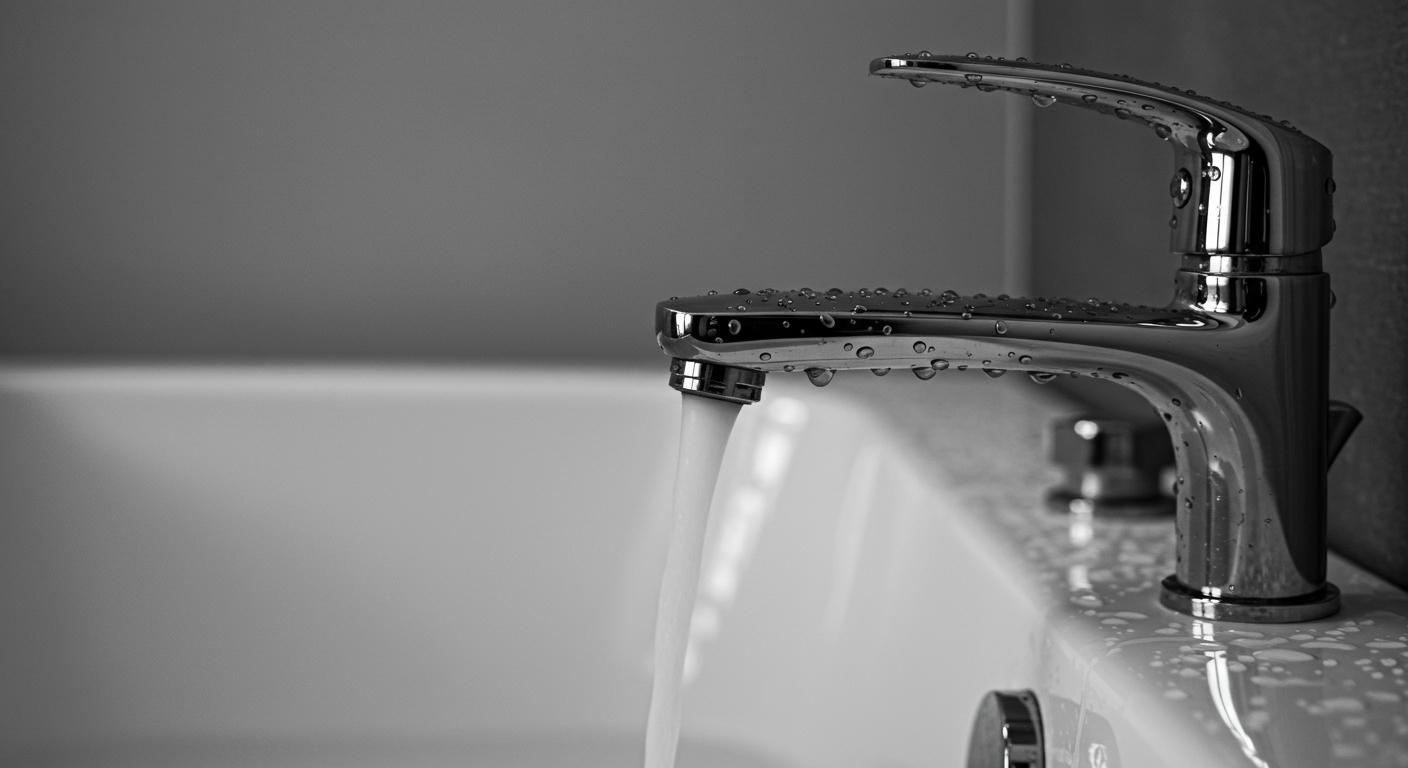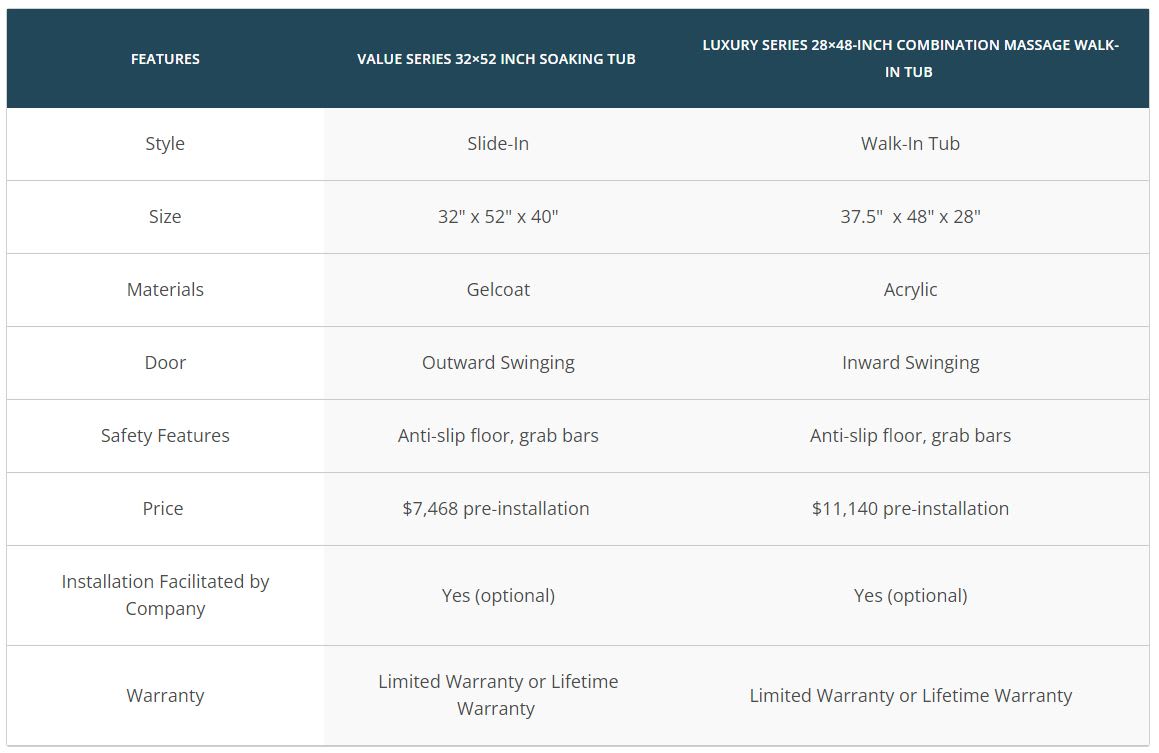The Best Walk-in Tubs of 2022
April 26, 2023
Anthony Navarro

April 26, 2023
Anthony Navarro


Many Americans want to “age in place,” that is, stay in their own homes as they get older. According to a 2022 survey of the University of Michigan National Poll on Healthy Aging, nearly 9 in 10 American adults (88%) aged 50-80 felt the importance of staying at home for as long as possible. Many other seniors wish to stay with relatives long-term instead of moving into a retirement community. For seniors discussing one of these two options with their loved ones, the key question is, “how can I make my daily routines within this home easier on my body?”
Seniors can modify their homes and routines in many ways so that personal care becomes safer. Installing a walk-in tub is one popular option to increase safety, comfort, and independence. Walk-in tubs usually include many modifications that the National Institute on Aging recommends for “fall proofing” a home.
To help you better understand walk-in tubs and how to choose one, we’ve created a guide that profiles walk-in tub companies and their products. You’ll find details about pricing, warranty, installation, customer service, safety features, tub styles, upgrades, and more. As you shop, this guide can help you narrow your list of companies to ones that offer the services you value.

Contributing Expert
Heather Suri, BSN RN CMC
Heather Suri is a Registered Nurse with 20 years of experience primarily in geriatrics and hospice. She holds a Bachelors in Nursing from Western Governors University and is certified as a Care Manager through NACCM. She is a member of the Aging Life Care Association at the Advanced Professional level. In addition to practicing as a Geriatric Care Manager, Heather is the Director of Nursing for Griswold Home Care NoVA West. Heather volunteers her time in the community through a program she developed called The Caregiver Resource Hour, as well as for Girl Scouts of America.
For a quick overview of our findings on the top 11 walk-in tub companies in the U.S., view the table below.
* Walk-in Tub pricing can be difficult to determine. Prices in this chart do not include installation unless otherwise noted.
Ameriglide brings many types of accessibility aids into the lives of seniors and those with disabilities. This company strives to offer quality and premium safety features while keeping starting costs as low as possible. To that end, Ameriglide offers fifteen walk-in tubs from its “Sanctuary” line of products.
We’ve reviewed four of Ameriglide’s walk-in tubs: a mid-sized model with fairly basic features, a larger deluxe model, a large wheelchair-accessible model, and a model that includes a shower enclosure. These four tubs show some of the variety this company offers, but several more great options are available, including extra large and extra small options.
One of this company’s best offerings is the previously mentioned Shower Enclosure model. This versatile model blends affordability and therapy features and comes in two different sizes. The Shower Enclosure tub lives up to Ameriglide’s mission of accessibility at a great price.
*All prices listed here are starting costs only. They do not include the costs of shipping, installation, or optional upgrades. Note that installation costs can be highly variable, and that shipping from Ameriglide typically costs $385. Ameriglide occasionally runs sales, in which case prices may start lower.
Ameriglide has a large selection of walk-in tubs and walk-in tub/shower combinations. It also sells bathtub conversion kits for altering the accessibility of your existing tub. You can buy all Ameriglide items directly from the company’s website, and multiple financing options are available. Below you can learn about just a few of the many models that this brand offers.
Installation
In many states, homeowners may choose to use an Ameriglide Authorized Contractor to install their walk-in tubs, or they can find a local installer. Installation costs vary significantly. Ameriglide lists contractors by state and province on its website. Currently, installation services are listed for only about 30 states, so many seniors will need to arrange for their installation with a local contractor. Scroll to the very bottom of any Ameriglide page and click on “Authorized Ameriglide Contractors” to access the list.
Warranty
Ameriglide offers a limited but useful walk-in tub warranty. Below, you can learn about the basic terms of this warranty. A few models may have differing coverage, however. It’s wise to check the documentation on your individual model prior to purchasing.
Warranty coverage:
Note that Ameriglide warranties typically exclude excessive wear and environmental or cleaning damage to the surface. Numerous other exclusions and fees can apply, and labor costs associated with replacing parts are typically not covered. Seniors should note that Ameriglide tubs sold today may be offered with different warranty terms than they had in the past.
Pros:
Cons:
Spirit Walk-In Tubs is a small but mighty champion of the American-made sector of the industry. It impresses in several categories, including customer service (you may just speak with the owner of the company, Ron, when you call!) and reasonable cost. The company’s willingness to discuss pricing in detail over the phone is refreshing.
More than anything else, though, what sets Spirit apart from its competitors is that the step into all of its tubs is between 0-2.5” tall. A step height of even 2.5” is practically unheard of in the industry. Most competitors’ tubs have more than a 6” step, so Spirit Walk-In Tubs is a great choice for those whose top priority for their tub is low step height.
Spirit does not provide detailed charts of its fourteen different walk-in tub models online. Instead, the company focuses on speaking with clients and tailoring each tub selection to the needs of the homeowner. Talking to a Spirit Walk-In Tubs staff member is a necessary and helpful step in the purchasing process.
Rather than listing individual models online, Spirit likes to get to know its customers needs and suggest a tub size that will work best. As such, we do not break down individual tub models below. Instead, we give an overview of the range of options that are available from Spirit.
Spirit Walk-In Tubs are highly customizable, but they will generally measure somewhere in this range: 40″ x 30″ x 50″ – 60″. Extra-wide, deep soaking, petite, and two-person models are typically available. All Spirit walk-in tubs are crafted from a seven-layer marine gel coat fiberglass and made without internal frames but are pretty stable. Unlike tubs with frames, these sit directly on the floor, enabling them all to have a 2.5″ or lower step, compared to steps of 3″ -9″ in other walk-in tubs. Seniors looking for more information on the quality construction of Spirit Walk-In Tubs may call the company or look directly at the manufacturer’s website (BOCA Walk-In Tubs).
Spirit’s pricing can vary substantially depending on the exact features you select. Online and over the phone, Spirit says its walk-in tubs cost between $6,000 and $10,500, including shipping and installation. This may be as much as half the cost of comparable tubs from some leading brands, making the company a great low to mid-range option for buyers hoping to stick to a budget.
Safety Features
Installation
Spirit Walk-In Tubs are installed by a small network of installers who work closely with the owner of the company. Its range of service is West Coast, Texas, Louisiana, Mississippi, Florida, Georgia, Missouri, Illinois, and East Coast. Installers may travel considerable distances to reach a client’s home. In many cases, Spirit offers one-day removal and installation.
If you live outside the stated service areas of but are still interested in a product from Spirit Walk-In Tubs, you may want to call to see if the company will make an exception or if its service area is set to expand to your region. If you are interested in the features of the BOCA tubs that Spirit Walk-In Tubs sells but liv
Warranty
Spirit Walk-In Tubs offers a full lifetime warranty on all tubs, motors, and faucet sets. This warranty includes labor and has few, if any, exceptions. This excellent warranty can help you keep costs low over time and gives you peace of mind that you will be able to enjoy your tub for years to come.
With Spirit, if your tub has a problem, the company will work directly with you to solve it in a timely manner. To file warranty claims, customers simply need to call the company and the nearest technician will be sent out to your home as promptly as possible to assess the situation and get any necessary repairs started.
Pros:
Cons:
Hydro Dimensions, an innovator in the walk-in tub industry since the early 1990s, offers sixteen different walk-in tubs in two different product lines: the HD Series Line and the Specialty Line. Between the two lines, there are 17 different models. We’ve reviewed a tub from each line so that you can get an idea of what’s offered, though there are many other models available. In general, the tubs in the specialty line are larger than average or are built for those with limited mobility.
In addition to carrying so many tub models, Hydro Dimensions can customize your tub with a great range of therapy and comfort features. There are six distinct levels of jet upgrades plus some add-on features like lights and heaters.
Even with upgrades, Hydro Dimensions tubs remain fairly reasonable, especially since their prices always include installation costs. Hydro Dimensions truly brings value to the walk-in tub market and makes top-quality therapy options accessible.
*rounded to the nearest inch
Seniors should note that Hydro Dimensions never sells directly to its own customers, nor does it sell its tubs through large retail chains. Instead, customers buy from approved Hydro Dimensions Dealers, which the company can connect you with. The availability of some of the models or features below may sometimes be impacted by the dealer in your area.
With over 140 years of industry experience, mergers, and growth, American Standard is a leader in the world of bathroom and kitchen fixtures. The name of American Standard has changed a few times over the years, but its core value of innovation has remained.
Now American Standard helps consumers with the next wave of home improvement- making homes accessible to the elderly and disabled. This company offers a large selection of walk-in tubs at a variety of price points and styles. Since the cost of every tub and its upgrades are clearly labeled online, American Standard takes the guesswork out of comparison shopping and makes life that much easier for buyers.
We’ve chosen to review one model to represent American Standard’s Value Series walk-in tub line and another to represent its Luxury Series line. The Value Series model represents a great wheelchair accessible choice, and the Luxury Series model is a great example of a tub with more advanced features.

American Standard is an unusual company due to the fact that it lists over 200 different models on its website. In reality, many of these models are similar, and will be categorized as an air bath, a walk-in whirlpool tub, a combination massage tub, or a deep soaking tub. They’ll be further split into product lines, as well. Below you can learn more about two of the many great options offered.
Installation
Homeowners can buy American Standard tubs without an installation package, or they can choose to receive a free installation estimate. An online form on American Standard’s website can be used to schedule an in-home visit from an American Standard Safety Specialist. Seniors should keep in mind that installation costs can vary tremendously based on location, the size of your bathroom, and other factors. Many retailers, such as Lowes and Home Depot, may offer their own installation packages, so enquire locally if you wish.
Warranty
American Standard offers two distinct walk-in tub warranties. If you opt to have one of American Standard’s factory-trained specialists install your tub, your tub will have a complete lifetime warranty that includes installation and labor. This is one of the best warranties available out of all the companies we reviewed.
American Standard offers a limited warranty for its walk-in tubs that are not installed by one of its specialists. In this case, the coverage for acrylic tubs is better than the coverage for high-gloss Gelcoat tubs.
Limited Acrylic Warranty
Limited Gelcoat Warranty
Pros:
Cons:
Independent Home has been bringing gel coat walk-in tubs into seniors’ homes for over fifteen years. A small family-owned business, Independent Home only makes walk-in tubs. All of its resources are focused on supplying you with the best of this industry niche.
The number of models Independent Home carries isn’t overwhelmingly large. Yet, it manages to have options for many different body types and abilities and many different home space requirements. Some of Independent Home’s options are a slide-in tub, a shower-tub hybrid, a tub with a sling, a bariatric tub, and a cube-like tub that works well in small bathrooms.
We’ve chosen to review the Access Walk-In bathtub and the Cube Walk-In Bathtub because these two tubs appeal to different needs.
Installation
Independent Home installers can often complete installation in just one or two days. Before the installation, a company representative walks homeowners through pictures and videos of similar installation projects. Hence, they know just what to expect and take some stress out of the process. Installation is always included in the price of your Independent Home walk-in tub.
Warranty
Independent Home offers a “no-nonsense” full lifetime warranty on all its tubs. The warranty is one of the few in the industry that is an added cost. While no one wants to add more to this already significant purchase price, adding a warranty can be a smart move.
Full lifetime warranties that don’t list a considerable number of exceptions and special circumstances are somewhat rare, and Independent Home’s warranty is one of them. This warranty will offer better coverage than many free warranties on the market. If something breaks or stops working correctly, Independent Home technicians will come to your home and repair or replace what’s broken without charging you for parts or labor. This warranty may even extend to the complete replacement of a tub if that step is warranted.
Pros:
Cons:
Freedom Bathtubs by Accessibility Professionals Inc. is on a mission to bring safety, relaxation, and independence to all seniors. The company’s line of Freedom Bathtubs offers just two models: a walk-in tub model and a slide-in model, both of which are simple and practical.
Accessibility Professionals sells one of the best wheelchair accessible tubs on the market. Built with a low step height (6”) compared to many other slide-in tubs, this slide-in option offers increased safety for those with mobility challenges. It also has a heated seat for extra comfort and comes at a very competitive price, especially for tubs with a heated seat.
*Rounded to the nearest inch
Installation
Accessibility Professionals does not handle installations itself, but it can make the installation process easier for you by referring you to a dealer. You may also choose to find your own contractors. Seniors should bear in mind that installations can cost thousands of dollars in some cases, depending on their complexity.
Warranty
Accessibility Professionals walk-in tub warranties cover different parts of the tub for different periods of time. The warranty applies to defects in workmanship or material, and it does not cover labor costs.
This means that if, for example, the hydrotherapy pump on your walk-in tub stopped working two years after you got the tub, the company would supply you with a new pump, but they would either charge you for the labor costs of removing the old one and installing the new one, or else they would simply expect you to find your own repair person and pay them to remove and replace the part.
You can see more complete coverage details below:
Pros:
Cons:
Ariel connects seniors to designer-style bathroom fixtures without the designer price tag. Through Ariel, walk-in tubs become accessible to those that otherwise may not have room in their budgets for such a significant purchase.
Some of Ariel’s tubs sell for less than $2,000 (pre-installation), an uncommonly low price in the industry. Its most economical models are its “soaker” tubs (tubs without jetting and therapy options). Despite the low cost of Ariel’s soaker models, these tubs are functional, attractive, and equipped with hand showers and faucets. Choosing an Ariel soaker model is a great way to move away from the dangers of using a reclining tub.
Ariel has many walk-in tub listings on their website, but they have only one walk-tub shape (standard walk-in with an inward swinging door). It comes in five slightly different sizes and three levels of therapy. Each tub also comes with the option of having the door on the right or left side. These options, paired in different ways, account for all of the listed Ariel models.
We’ve selected one of the least expensive soaker tubs and one of the most costly dual therapy tubs in very similar sizes to compare to each other. Comparing these two models will give you an idea of Ariel’s price and feature ranges.
NOTE: Homeowners should ask questions about “fast” features that rely on extra wide ¾” diameter plumbing. Many homes have existing ½” pipes that are not compatible. A tub with nonstandard plumbing could require home renovation, or it might simply fail to live up to its speed claims. To avoid disappointment, be sure to ask for details before signing on for one of these upgrades.
Ozone Generators: Walk-in tubs that come with air therapy may also have an ozone generator included or as an upgrade. An ozone generator splits oxygen atoms to create ozone, and then it pumps that ozone through the air jets to kill bacteria. The ozone later converts back to oxygen on its own. This system is both effective and natural.
UV Sanitizers: UV Sanitizers in some walk-in tubs kill bacteria by forcing them to mutate. In a walk-in tub, the water that flows through a jet system passes by a UV light. The sterilizer is working for the duration of the bath. Not all companies offer these sanitizers, and even with a sanitizer, your tub’s jet system may need an occasional cleansing cycle using a chemical agent.
Purge Cycles: These systems are often called “automatic purge cycles,” and they activate when you exit your bath. You will hear a noise as a pump turns on and draws all the extra water out of the tub’s pipes, ensuring that standing water won’t linger to mold or grow bacteria.
Walk-in tubs can be useful to a diverse group of seniors. Below you’ll find a list of those who find walk-in tubs especially convenient or beneficial.
Contrary to popular belief, repeated falls are not an inevitable part of life as a senior; instead, they are preventable. One of the five recommendations of the National Council on Aging (NCOA) for preventing falls is to improve home safety.
If you’re planning on aging in place, even if you are a relatively young senior in perfect health right now, you should start considering ways to make your home safer. Minimizing fall risks before you ever fall can save you money and health complications in the future.
If you’re a senior looking to upgrade your bathtub as a preventive measure, here are some features you should look for.
If you’ve already experienced a fall in your home or bathroom, chances are you’ve become very aware of how your environment can affect your balance. Because the bathroom is considered the most dangerous room in the home, you may consider performing a Home Safety Assessment that focuses on the bathroom to identify issues that could cause a fall and then make adjustments or modifications to reduce the risk. You may find during your Home Safety Assessment that it’s time for you to remove a traditional bathtub or shower that you used to enjoy and replace it with a safer option
Studies show that seniors who experience a fall tend to limit their activities out of fear. Having a tub that’s built with your needs in mind can give you the confidence to actively and consistently care for your personal needs, even if you’ve experienced a painful bathroom or home fall in the past.
Below are some features to look for in a walk-in tub if it’s a challenge to stay on your feet.
If you’re a senior who has serious disabilities or mobility issues, there are walk-in tub options for you, too. Getting a tub that doesn’t require much vertical and horizontal movement can reduce the likelihood of you or your caregiver being injured while you transfer to your bath.
In addition to safety features like low step height, grab bars, and anti-slip texture, look for the following designs in a walk-in tub:
Research suggests that obesity in seniors increases their risk of falling because it interferes with balance and the ability to regain lost footing. Obesity can also cause joint problems. If you’re medically considered obese or just larger than the average senior, you may find average-sized tubs unsafe. You may even fear getting stuck in an ill-fitting tub.
A bariatric walk-in tub (bariatric means “relating to the treatment of obesity”) can help reduce your risk of bathroom falls, address your space problems, and help you with managing joint pain with its soothing warm water.
Even if you’re working with a doctor to lose weight, investing in a large walk-in tub now could be a smart choice. After weight loss, you’ll still be able to enjoy the safe, comfortable features of your tub for many years.
Below you’ll find a list of what to look for in a tub if you’re larger than average.
While the various therapy upgrades available in walk-in tubs will never cure chronic conditions like arthritis, poor circulation due to diabetes, or injured muscles and joints, there is some evidence that the available therapies can alleviate symptoms. These therapies can help seniors manage their pains or improve their sense of well-being during difficult times.
In addition to therapeutic benefits, seniors with chronic pains and conditions will benefit from the safe, user-friendly designs of walk-in tubs.
Below are some features to consider for your walk-in tub if you live with a chronic condition:
When buying a walk-in tub, you’ll need to consider several important factors. Before you even begin the shopping process, be aware of these key factors that will go into choosing the right walk-in tub for you.
Tub Style
Decide on a tub style that you’re confident will meet your needs. Don’t try to settle for a tub that doesn’t have the right safety features or size. Chances are if the tub style you need is too expensive through one brand, you’ll be able to find a comparable model at a lower cost from a different company.
Safety
Finding a tub with as many safety features as possible can help your tub keep up with your evolving needs throughout the years. One grab bar, anti-slip floor, and a 9” or lower step is the unwritten industry standard for safety in walk-in tubs, but looking for even better safety is a smart move. An ADA-compliant seat, additional grab bars, a super low step, or an outward swinging door are all good safety features to consider.
Optional Features
Consider creating a list of which optional features you consider essential, which you’re interested in for the right price, and which you don’t care about at all. Refer to our “Optional Features” section to see what’s generally available.
Companies differ widely on what they consider “optional” versus “standard.” It’s always worth reading the fine print on a model to know what exactly you’re getting.
Warranty
If you want the absolute best warranty available, look for a lifetime warranty that covers labor and parts. If a warranty isn’t a concern to you, you will find that walk-in tubs with limited warranties are often the most economical, at least in the short term. Not having a quality warranty may leave you on the hook for repair costs down the road, though.
Cost
A walk-in tub is a significant purchase, comparable to the cost of buying a car. In our research, the lowest walk-in tub cost that we’ve seen was just shy of $2,000, pre-installation. The highest pre-installation prices we have encountered have been around $11,000.
Sometimes a tub that seems inexpensive may only be so because it has few features. Also, some inexpensive walk-in tubs are built in another country, which may not suit your preference.
If a walk-in tub quote (installation included) exceeds about $10,000-$12,000, you should consider why that might be. Buying a tub that’s more or less expensive than the typical range isn’t necessarily a wrong choice, but it merits asking additional questions before you commit.
For information on getting help with these costs, view “Walk-In Tub Financing and Payment Assistance for Low-Income Seniors.”
Below, read our step-by-step guide to choosing and purchasing a walk-in tub.
Which tub style you should choose is determined in part by preference and in part by need.
Aside from the size and shape of the tub model you need, secondary considerations include which side the tub’s door is hinged on and whether the door swings inward or outward. Most companies let the buyer choose which side the door hinges on. Doors that swing inward are ideal for bathrooms with limited space.
Use these three steps to make sure you’re searching for a tub that’s realistic for your space.
Having a range of what you’d ideally like to spend on this project can help you narrow your search. Decide early on the maximum amount you can pay out of pocket and think about whether or not it’s financially smart for you to pursue a grant or loan to supplement your funds.
Many walk-in tubs cost between $6,000-$12,000 including installation, but there are also more and less expensive options on the market.
As you begin your walk-in tub search, it’s important to understand that there are two basic kinds of walk-in tub companies when it comes to pricing: those that are willing to tell you their price range early in the sales process and those that won’t disclose any pricing information until they visit you in your home.
PRICING DISCLOSURE - WHAT DOES IT MEAN?
Early Cost Disclosure
A company that’s fairly open about their costs will either list tub prices online (on their own websites or through other retailers), speak about costs over the phone when you ask, or maybe even email you pricing information when you request it.
You probably can’t get an exact price on installation until after someone has looked at your home, but you’ll at least be able to get a “ballpark” figure. After discussing details with you, a customer service representative may say something like, “this could change depending on your installation needs, but I expect this project to cost you between $6,000-$8,000.”
Late Cost Disclosure
Companies that aren’t as open about pricing will only discuss it with you when they visit your home. Over the phone, sales representatives may say something like, “we believe it’s unethical to talk about pricing now because there are too many factors that affect the price. When can I schedule a no-obligation in-home consultation? It’s always free and your quote will be good for a year.”
Some of the most well-known walk-in tub brands (like Kohler and Safe Step) operate on a “closed” pricing policy. It’s difficult to say anything definite about the affordability of any of these companies.
Is one pricing system better than the other?
In our review, we’ve included companies that disclose costs early and late in the sales process because both kinds of companies make excellent walk-in tubs.
Which kind of company you should explore comes down to preference. If you’re frustrated by the thought of having to let someone into your home before you can get any idea of the company’s price range, then you may want to explore companies with more transparent pricing.
A reputable company of either style will not charge you for a quote or try to force you to decide under pressure if you’re going to buy from them.
Once you’ve got some information on what kind of tub you need and what kind of money you’d like to spend, you can start looking into different companies.
When looking at companies, consider the following:
No matter what kind of tub you want, you’ll benefit from comparing the costs, service, and features of tubs from at least three different companies. If at any point a company strikes you as dishonest or manipulative, feel free to walk away, knowing that you have other options.
Looking up companies online is informative since you can view pictures, videos, and blueprints. Sometimes websites have incomplete or outdated information, though. Calling and taking notes is the most certain way to learn about a product.
A crucial choice to make when purchasing a walk-in tub is who handles the installation.
Installation Options
Some walk-in tub companies always handle installations of their products, some never handle installations, and some companies give you the option of handling it for you or letting you find your own installer. Many companies maintain a list of “dealers” or “approved installers” that, while not technically part of the company, are experienced with the company’s products.
Ultimately, an installer from the walk-in tub company may be the most economical choice.
| Note: It’s wise to use the services of a CAPS-certified contractor (Certified Aging in Place Specialist) who can not only install the tub, but also evaluate and retrofit the accessibility of the bathroom overall. “Often I see people put in a walk-in tub, only to find that 6 months later the vanity/sink area is no longer working for them as their mobility continues to change,” says Heather Suri, Caring.com aging expert. “Having a ‘big picture’ viewpoint can save money and frustration in the long run!” |
Installation Costs
While costs may sometimes be lower, especially if you buy a “soaker” (no jet features) walk-in tub, it is safe to consider $2,000 or $3,000 as a minimum installation cost.
Installation costs may even reach $5,000 or more if significant electrical work, a new water heater, and plumbing upgrades are required. In such an unlikely case, homeowners may spend more on installation than on the tub itself. Additionally, keep in mind that labor costs vary geographically.
Risk factors for high installation costs include:
If an installer is telling you that you need major home alterations, you may want to confirm that with a second opinion or consider a tub that’s more compatible with your home as it is.
Many warranties need to be “activated” or “registered” before they are considered valid. You can register your warranty after your tub is installed. Filling out a short form online or mailing a form to the manufacturer is likely all that you need to do.
Walk-in tubs may improve the safety of seniors with mobility, strength, or balance issues, but they are a significant investment. Walk-in tubs range in price from $2,000 to $20,000, and their installation can add an additional $2,000 to $10,000.
Fortunately, there are payment options available to seniors regardless of the price of the walk-in tub or their income level. With government assistance or financing, almost all seniors can find a way to pay for a walk-in tub that will allow them to age independently, gracefully, and safely. Below, we explain the many options available to help seniors pay for a walk-in tub.
While Medicare doesn’t typically cover walk-in tubs, exemptions may be made in some circumstances. State Medicaid programs and waivers are much more likely to provide financial assistance for walk-in tub purchases. Additionally, home modification grants are available to veterans through the VA and both loans and grants are options for low-income seniors living in rural areas. Seniors or their caregivers may also be able to deduct walk-in tub costs as a medical expense when filing taxes.
Medicare policy excludes coverage for walk-in tubs, as they do not meet the requirements to be considered durable medical equipment. However, companies such as American Tubs and Kohler claim that Medicare might reimburse seniors after purchasing one if it’s medically necessary and a doctor writes a prescription for it. Such claims may be inaccurate, and if seniors purchase a walk-in tub Medicare may never pay for any of it. Thus, it’s extremely important to work closely with your walk-in tub dealer, get clear on the reimbursement claims, and confirm Medicare participation if you need Medicare to pay for your new tub.
Medicare Advantage plans are much more likely to cover the costs of a walk-in tub. This is due to an expansion of supplementary services that occurred in 2019, allowing Medicare Advantage plans to provide benefits that “reduce the impact of injuries or conditions” as well as “reduce avoidable emergency room visits.” However, coverage for a walk-in tub is never guaranteed and may vary by plan and state. Reach out to your provider to inquire about your specific Medicare Advantage plan’s policy and whether or not they extend coverage to walk-in tubs.
As the senior population in the United States grows, state governments and their affiliated Medicaid programs want to help seniors age in place so that institutions don’t become overcrowded. This policy of supporting aging in place is good news for seniors because it means state governments are making funds available for age and accessibility-related home improvement projects.
Medicaid programs differ from state to state, and some are broad enough to cover walk-in tub purchase and installation. Many states also have special Medicaid programs and waivers that cover services that would otherwise be excluded. A list of such programs and waivers that could help with the costs for a walk-in tub is provided in the following table.
WARNING: Reverse mortgages remain controversial despite recently enhanced regulations on them. Those who get a reverse mortgage are very unlikely to pass their home on to their estate when they are gone. With a reverse mortgage, there’s also risk of your surviving spouse or other co-habitants being foreclosed on while they are still living. If you’d like to learn more about reverse mortgages, take a look at this HUD article, and beware of scams.
If you’d like to read a more detailed comparison of HELOCs, Home Equity Loans, and Reverse Mortgages, you may find this article helpful.
Financial Resource Locator Tool
Paying For Senior Care’s Eldercare Financial Assistance Locator can help you find a financial program that meets your individual needs. Fill out all the required information, check the box for “Home safety and accessibility modifications,” and then when given the option be sure to check the “Walk-in bathtubs” box.
Area Agencies on Aging
Throughout America, states designate privately and publicly run Area Agencies on Aging (AAA’s) that can help you with a variety of independent living needs. AAA’s may be able to connect you to the appropriate financial resources that you need to get your walk-in tub project started.
To find an Area Agency on Aging in your community, enter your zip code into this government website’s search tool.
Many brands carry walk-in tubs specifically designed for wheelchair users. These tubs are called transfer or slide-in tubs, and they feature doors that swing outward to provide unhindered access to the seat. A transfer tub with a step no higher than about 5” will be the easiest option for you to get into. If you have limited mobility, you should also make sure that the transfer tub that you select has controls that are easy for you to reach without moving from a seated position.
Walk-in tubs can be purchased through a variety of sources. Many brands can be found through national home improvement chains. The number of walk-in tub models available through chains is sometimes limited, however. Many companies also sell through showrooms and contractors. Some brands will sell directly to you, offering or requiring that you use their certified installer.
Only a few walk-in tub brands don’t offer a warranty. However, the coverage level of warranties differs greatly from brand to brand, even when the warranties are advertised with similar language. The most common form of limitation for warranties is time. Many warranties expire after five or ten years. Some warranties cover every single piece of the tub, but most cover only specific components and exclude things like the tub’s finish or the motor. Since there’s so much variation in warranties, it’s best to read the fine print on the warranty page.
Not every company offers a payment plan, but many do. Most brands that give you the option of making payments on your walk-in tub offer that option through a third party such as a bank or even an online service like PayPal. You will usually pay a bit more in the long run if you use a payment plan because you’ll pay some interest. It’s important to remember that a payment plan is a loan and should be entered into cautiously.
The safety of a walk-in tub depends on its individual design and your health. If you’re concerned about safety, you’ll want to find a tub with the smallest step height possible, well-placed grab bars, and anti-slip surfaces. Step height varies from brand to brand, and it’s the biggest factor in safety. For some bathers, a walk-in shower with a seat may be the preferred safety option because some walk-in showers can give caregivers more room to offer assistance.
Prior to installation, someone will need to measure and inspect your bathroom, and they may have questions about your plumbing and water heater. If your water heater is especially small, they may suggest that you replace it before continuing with your tub installation. After measurements are taken and an estimate is created, you’ll need to approve the estimate and schedule the installation. Once work begins, many installations take two days or less. If you need to replace your water heater or have other major alterations to your bathroom, however, installation could take much longer.
Not all walk-in tubs are made of the same material. Some are crafted from acrylic and some are crafted from gelcoat over fiberglass. Acrylic is often said to be less prone to stains and damage, but it’s also more expensive than gelcoat. Gelcoat tubs are usually made with either three or seven layers of a resin coating. A seven-layer gelcoat walk-in tub, which may be called “marine grade” gelcoat, will be more durable than a three-layer gelcoat. The advantage of using gelcoat to make a tub is that it costs less than acrylic and can be molded into a greater variety of shapes than acrylic can be.
Walk-in tubs are specially-designed tubs that work like a traditional bathtub. Basically, it’s a big basin filled with hot water for the bather to immerse in. The most significant difference is that a walk-in tub has a door on its side that opens inward or outward to allow the bather to walk in. Once the door is closed with the bather inside, the bathing area is completely sealed and ready to be filled with water.
Walk-in tub prices can range between $2,000 – $12,000, depending on various factors like brand, type, size, and features, not including the installation. The average price for a basic soaker is about $2,000, and as much as $12,000 for premium models with therapy systems that offer a spa-like experience. Two-seater tubs may cost as much as $5,000 – $20,000.
According to Forbes, a walk-in tub installation may cost between $2,000 to $10,000. Several factors dictate the installation cost, such as how much work and materials are needed. For example, if you’ve purchased a 60-gallon walk-in tub and your water heater only has 50 gallons capacity, upgrading the tankless water heater will bump up the costs significantly.
Walk-in tubs are designed primarily with safety in mind, especially for older adults that prefer to age in place. One of a walk-in tub’s most common safety features is a grab or handlebar that allows the bather to navigate the tub safely. Walk-in tubs also have anti-slip or non-skid floors to prevent bathers from slipping and falling.
No. Unfortunately, Medicare doesn’t typically pay for walk-in bathtubs. Medicare only covers products that are considered “durable medical equipment,” such as walkers, wheelchairs, oxygen tanks, etc. Since walk-in tubs don’t meet the definition of durable medical equipment, they’re generally not covered by Medicare.
Stay up to date on the latest real estate trends.

November 4, 2025

February 24, 2025

January 24, 2025

December 7, 2024

October 26, 2024

October 23, 2024

October 8, 2024

September 18, 2024

September 18, 2024
You’ve got questions and we can’t wait to answer them.